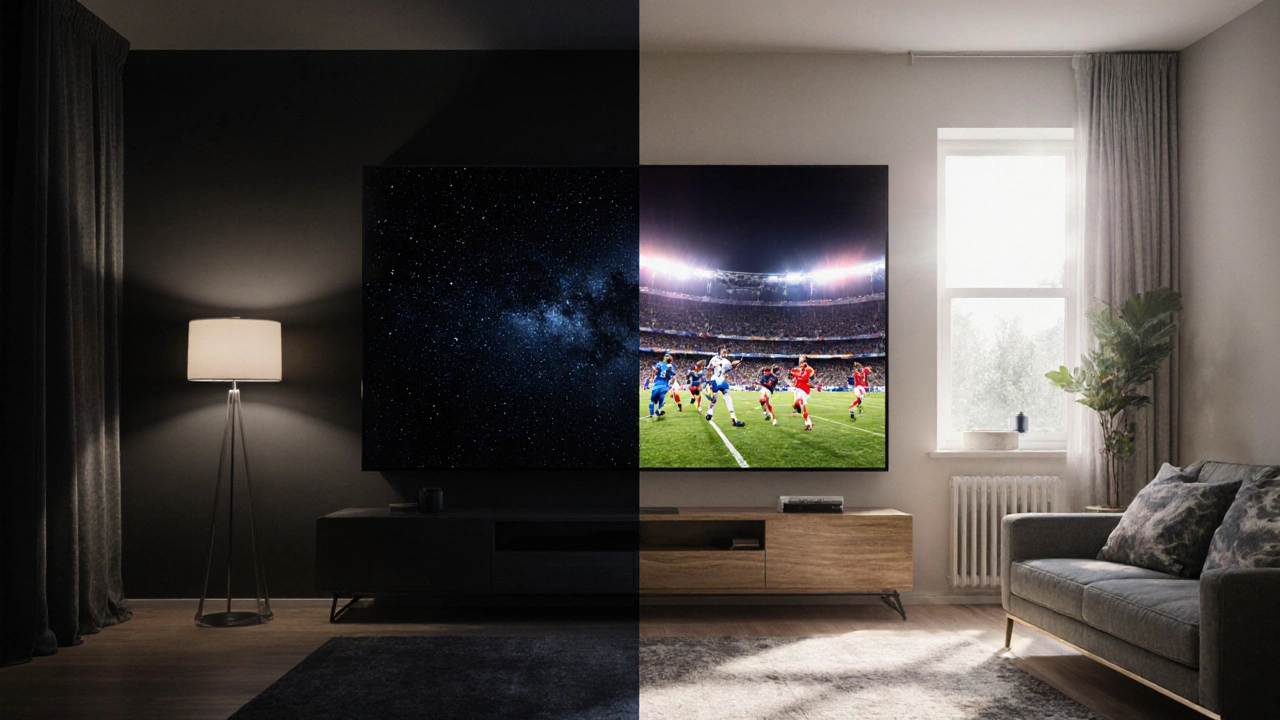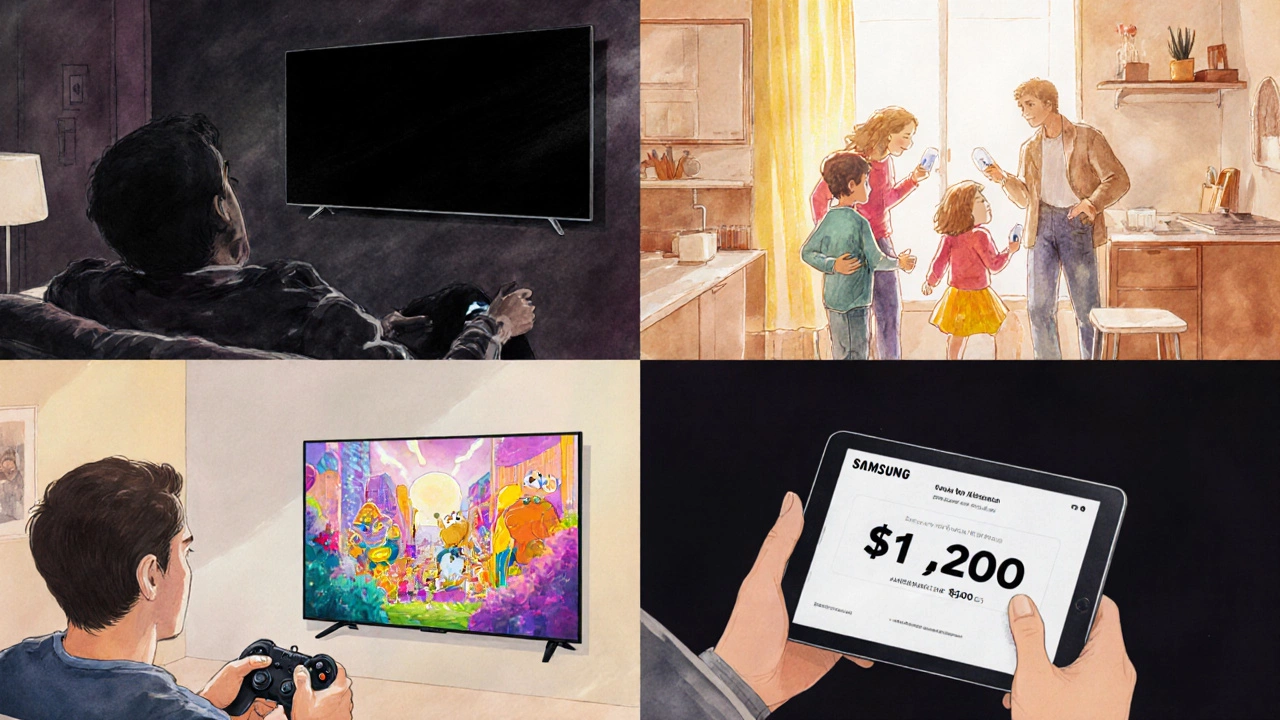
TV Technology Decision Tool
Answer these 5 questions to get personalized TV recommendations based on your viewing habits.
When you walk into a showroom and spot the massive screens, the first question that pops up is: OLED vs QLED. Both promise cinema‑like visuals, but they achieve it in very different ways. This guide breaks down the tech, the trade‑offs, and the real‑world experience so you can decide if the premium price of OLED actually pays off for you.
What Is an OLED TV?
OLED TV is a television that uses organic light‑emitting diodes for each pixel, allowing every pixel to turn completely on or off independently. Because each pixel emits its own light, OLED delivers perfect blacks, infinite contrast, and ultra‑wide viewing angles. The downside? Each organic layer degrades over time, which can lead to "burn‑in" if static elements stay on the screen for too long.
What Is a QLED TV?
QLED TV is a quantum‑dot LCD TV that layers a nanocrystal film over a traditional LED backlight, boosting color volume and peak brightness. The technology is championed by Samsung but licensed to other brands like Sony and TCL. QLED doesn't achieve true blacks the way OLED does, but it shines in bright rooms and is less prone to burn‑in.
How the Two Technologies Generate Light
OLED’s pixels are self‑emissive; they turn on or off on command. QLED, on the other hand, relies on a backlight that shines through a liquid‑crystal panel and a quantum‑dot layer. This structural difference explains most of the performance gaps you’ll see.
- Pixel control: OLED = per‑pixel, QLED = zone‑based backlight.
- Power consumption: OLED uses less power for dark scenes; QLED uses more consistent power because the backlight is always on.
- Thickness: OLED panels can be as thin as a sheet of paper; QLED panels need a backlight stack, adding a few millimeters.
Picture Quality: Contrast, Black Levels, and Color
Contrast is measured by the ratio between the brightest white and the deepest black. OLED’s ability to turn pixels off gives it a theoretical infinite contrast ratio, which translates to stunningly deep blacks. QLED achieves high contrast through local dimming zones, but light bleed around bright objects can lift the black level.
Color volume is another battleground. HDR (High Dynamic Range) combined with Dolby Vision pushes the envelope. OLED’s color accuracy is excellent out of the box, while QLED’s quantum dots let it reach higher peak brightness (often 1500-2000 nits) and a wider gamut in very bright environments.
Brightness and HDR Performance
If you binge‑watch in a dim bedroom, OLED’s perfect blacks dominate. In a sun‑filled living room, QLED’s brightness advantage shines. HDR formats such as HDR10+, Dolby Vision, and HLG rely on both high peak brightness and deep blacks. OLED typically peaks around 800-1000 nits, enough for most HDR content, but QLED can exceed 1500 nits, making highlights pop even under ambient light.

Longevity, Burn‑in, and Reliability
Burn‑in is the most talked‑about risk for OLED. Static logos, news tickers, or game HUDs left on for many hours can cause permanent imprinting. Manufacturers counter this with pixel‑shifting, logo‑luminance reduction, and screen‑sav er modes. In everyday use, most owners never see burn‑in, especially on newer 2024‑2025 models with improved materials.
QLED’s LCD base eliminates burn‑in concerns entirely. The backlight’s lifespan can exceed 50,000 hours, and the quantum‑dot layer is chemically stable. The trade‑off is that the panel can suffer from uniformity issues over time, such as “clouding” where parts of the screen become slightly brighter.
Gaming, Refresh Rates, and Input Lag
Gamers care about response time, refresh rate, and input lag. OLED panels have pixel response times under 1 ms, making motion blur virtually invisible. QLED panels, especially those with VA panels, can be a few milliseconds slower, though many 2024 models use OLED‑like fast‑response layers (e.g., Mini‑LED). Input lag on both platforms is now sub‑10 ms for 120 Hz HDMI 2.1 modes, so the difference is negligible for most players.
Price Landscape in 2025
OLED still carries a premium because of the costly manufacturing process. As of October 2025, a 55‑inch OLED ranges from $1,300 to $2,200, while a comparable 55‑inch QLED starts around $900 and tops out at $1,500 for premium models with full‑array local dimming and quantum‑dot enhancements.
Screen size magnifies the gap: 65‑inch OLEDs hover between $2,200-$3,500, whereas QLED 65‑inches sit between $1,400-$2,500. Sales and promotions can narrow the gap, but the baseline price premium for OLED remains.
Choosing the Right Technology for Your Lifestyle
Here’s a quick cheat‑sheet:
- Dark‑room movie lovers: OLED for unrivaled blacks and contrast.
- Bright‑room TV hub: QLED for peak brightness and vibrant HDR.
- Gamers who play fast‑paced shooters: Either works, but OLED’s ultra‑fast pixel response gives a slight edge.
- Kids’ rooms or content with static UI: QLED eliminates burn‑in worries.
- Budget‑conscious shoppers: QLED offers more screen real‑estate per dollar.

Comparison Table
| Feature | OLED TV | QLED TV |
|---|---|---|
| Contrast Ratio | Infinite (pixel‑level black) | ~5,000:1 (local dimming zones) |
| Peak Brightness | 800-1,000 nits | 1,500-2,000 nits |
| Color Volume (HDR) | Excellent, SRGB 100 % | Wide Gamut, DCI‑P3 95 % |
| Burn‑in Risk | Low-Medium (mitigation tech) | None |
| Viewing Angle | ≈178° (consistent) | ≈120° (color shift) |
| Refresh Rate | 120 Hz (native) | 120 Hz (native or interpolated) |
| Typical Price (55‑in) | $1,300-$2,200 | $900-$1,500 |
Real‑World User Experiences
John, a 34‑year‑old graphic designer from Austin, swapped his 65‑inch QLED for an OLED last year. He says the "true black" made his editing work feel more accurate, and he hasn't seen any burn‑in despite using a static UI for 3‑hour gaming sessions.
Maria, a mother of two in Seattle, prefers QLED because her kids love watching cartoons with bright colors. The TV's high nits keep the picture vivid even when the family room lights are on, and she never worries about ghost images from daytime news channels.
Future Outlook: 2026 and Beyond
Manufacturers are already teasing micro‑LED and dual‑layer OLED‑QLED hybrids for 2026. Those could combine the infinite contrast of OLED with the peak brightness of QLED, potentially making the "worth it" debate moot. Until then, the decision rests on your viewing environment, content habits, and budget.
Quick Decision Checklist
- Check your room lighting: Dark → OLED, Bright → QLED.
- Consider static UI use: Heavy → QLED, Light → OLED.
- Set a budget ceiling: Below $1,500 → QLED, Above $1,500 → OLED.
- Prioritize gaming or movie nights? OLED for ultra‑fast response, QLED for bright HDR.
- Future‑proofing? Look for models with HDMI 2.1, VRR, and built‑in AI upscaling.
Will an OLED TV get burned in after a few years?
Modern OLEDs include pixel‑shift, logo‑luminance reduction, and automatic screensavers. For typical mixed‑content viewing, burn‑in is rare. It becomes a concern only with prolonged static images like news tickers left on for many hours daily.
Can a QLED TV display true black?
QLED uses local dimming zones, which can get close to true black, but some blooming around bright objects remains. OLED still holds the edge for absolute black levels.
Which technology is better for HDR gaming?
Both perform well today. OLED offers faster response and perfect blacks, enhancing dark scenes. QLED’s higher peak brightness can make HDR highlights pop in bright rooms. Choose based on your typical lighting.
Do I need a special HDMI cable for OLED or QLED?
For 4K 120 Hz HDR content, use an Ultra‑High Speed HDMI 2.1 cable. Both OLED and QLED models support the same spec, so the cable choice isn’t brand‑specific.
Is the price gap closing?
Yes. Production yields for OLED have improved, and QLED’s quantum‑dot costs have risen. Expect OLED 55‑inch models to dip toward $1,200 by late 2025, while premium QLEDs edge up to $1,600 for full‑array versions.